Around the house is a necessary component of any communication suburban area. It includes not only drainpipes that remove moisture from the roofs of buildings, but also pipes and ditches running along the site, as well as small but important elements, such as a grill or blind area.
Storm sewers can be made with your own hands, the main thing is to decide on the layout, draw a draft and understand the device. The project of a storm shower is a properly selected plan of pipes, a collector and point wells. Examples of schemes on the Internet are many, they are equipped with photos and videos.
Livnevka in a private house
Remember how our shoes suffer after walking along the streets, where an insufficient road or sidewalk livevka is installed in the sewerage system. The shoes get wet and eventually can get unstuck. The same can be said about the house. Imagine how the water with every rain destroys the foundation of the house, floods the basements, affects the root system of plants and trees. To avoid the destruction of everything that is so dear to the owner of a private house, you need to make a sidewalk or lawn storming around the house, especially since its installation and installation are not that complicated, especially after viewing several videos.
Installation, according to the SNiP, assumes several basic elements: blind area, pipes, cast iron grids, trays, rainwater receivers and point wells. In addition, a complete system of storming involves the presence of stubs that prevent the flow of water in the opposite direction, siphons that prevent the appearance of an unpleasant odor, as well as sand catchers. No less important is the collector, where the sewage will flow. It can be replaced by the nearest pond or a special drainage well.
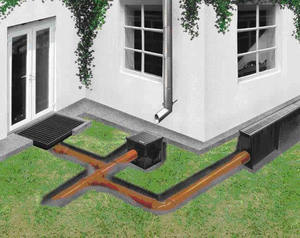
The scheme of storm sewage
The device of storming on the ground assumes a slope. To do this, you need to make an individual calculation of the rainfall of your site. On the video, made by professionals, it is noticeable that in any place a slight bias, equal to about two degrees, is maintained. The slope goes towards the point or line. This is not only removed a lot of video and done a lot of photos, but it is mentioned in the main documents in the construction - GOSTs and SNiPah. Livnevka on the roof is also regulated by SNIP.
Sidewalk livnevka in the sewer is, as a rule, along the edges of the path or sidewalk, so as not to interfere with free movement. The design of the sidewalk rainfall includes a blind and a grid for storm watering. Lawn livnevka in the sewers around the site is done where necessary, and does not interfere with the movement of people. For example, around a playground or a relaxation area with a barbecue. In this case, do not forget that there must necessarily be a grid for stormwater and blind.
The principle of water disposal is simple: through plastic pipes on the roof or ditches around the plot the water is collected in one place, along central pipes it enters the collector. Livnevka in the sewer can pass through the whole area or only to the part where the accumulation of precipitation is most likely. For proper water flow when installing plastic pipes, according to SNiP, slope is provided.
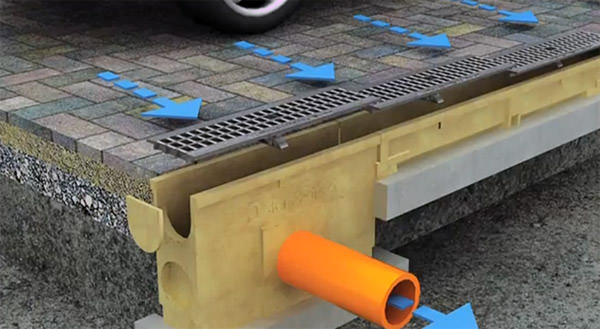
Livnevka
In the case of sudden temperature changes, the heating of the storm is required, so that all water and dirt leave the system before hibernation, otherwise the pipes may simply not withstand a low temperature. Especially from the cold, cast iron rainfalls suffer. Cleaning is carried out not only in autumn, but also in process of pollution of channels. Livnevka in the sewerage, made in accordance with SNiP, is quite simple in care.
Do not think that drainage and livnevka in the sewer system are two devices that no professional advises to unite in one project. On the contrary, the project of proper storm sewerage presupposes the availability of both ground communications, such as plastic pipes, and underground structures, such as drainage. Trays try to do in those places where the most likely accumulation of water. The trays are connected to the storm collector or to plastic pipes.
The system of stormwater: point or linear
There are two types of systems, a point and a linear drainage system. As a rule, they are combined. If you look on the web or read in magazines, then in the photo and video you can see that one type of system is rarely used. The construction of a storm shower is based on the principle of necessity and sufficiency.
Each person's shoes are perfectly familiar with city livnevki, whose work leaves much to be desired, creating water streams on roads and sidewalks. Very often after acquaintance of shoes with a deep puddle from a favorite pair of shoes, there are some pleasant memories. And if for the residents of the city on this all the troubles end, then for people living outside the city, the damage from rain rain can be much more palpable.
 In order that the rainwater flows do not destroy the base of the private house, let it happen and very slowly and do not flood the basement and basement premises, promoting the formation of rot and mold, and also to prevent the destruction of plant roots, it is important to build a livewood in the garden area - the water drainage system accumulating after precipitation. At the same time, due to the simplicity of the storm sewer design, everyone who wishes can perform all the work independently.
In order that the rainwater flows do not destroy the base of the private house, let it happen and very slowly and do not flood the basement and basement premises, promoting the formation of rot and mold, and also to prevent the destruction of plant roots, it is important to build a livewood in the garden area - the water drainage system accumulating after precipitation. At the same time, due to the simplicity of the storm sewer design, everyone who wishes can perform all the work independently.
Design features and purpose of the storm showers
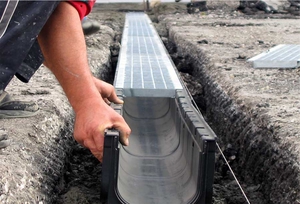 Under the storm sewage system is meant a complex of structures and ditches, which collect, filter and remove atmospheric precipitation in specially designed reservoirs or reservoirs. The main task of such a system is to eliminate moisture accumulating after the rain and creating discomfort to the inhabitants a country house, destroying different constructions and causing rotting plants. At the same time, the standard storm shower consists of certain elements:
Under the storm sewage system is meant a complex of structures and ditches, which collect, filter and remove atmospheric precipitation in specially designed reservoirs or reservoirs. The main task of such a system is to eliminate moisture accumulating after the rain and creating discomfort to the inhabitants a country house, destroying different constructions and causing rotting plants. At the same time, the standard storm shower consists of certain elements:
- a rainwater collector, which is a funnel, tray or linear tray designed to collect water;
- troughs and a drain pipe, through which the water resources collected after the rain are transported to the sand catcher, the filtration unit and further to the collector, cuvette, natural water reservoir or unloading field;
- inspection well, designed to monitor the operation of storm sewers;
- filtering devices or sand catchers designed to hold soil particles, plant fibers and other debris, thereby protecting the livevnu from premature contamination.
All these elements in the complex constitute an integral system that operates in a linear or pointwise fashion. If the canal system is laid in the ground, pipes should be used for its arrangement. If surface ditches are used, then plastic, asbestos or concrete gutters are mounted. To ensure the natural movement of rainwater or melt water to the filtration site, the sewage system must be laid under a certain slope towards the catchment area, unloading site or other reservoir.
Classification of storm water by the method of collecting rainwater
Based on the method by which atmospheric precipitation will be collected, the storm sewage classification into certain types is carried out.
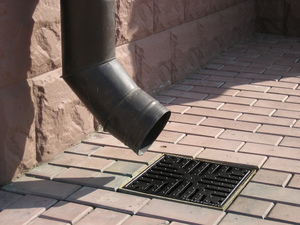
Based on the structural differences and the degree of coverage of the territory, the type of storm sewage should be selected. However, it is not rational to build on only these criteria when constructing a storm shower. In most cases, a storm shower sewage system at a country house equip on the basis of the peculiarities of the region of the construction of house building. Only based on the experience of the organizations involved in the construction of storm showers in the particular region selected and the type and depth of the sewage canals are chosen.
Features of design and calculation of rainwater
Implement any plans related to construction work without preliminary calculations - a senseless waste of money. If the storm sewer can not cope with the tasks assigned to it, then what is the point in its construction. At the same time, if you build too much sewage in a private house, this will lead to unjustified monetary costs. At the same time, the following information will be required for calculations and planning:
- Average values of atmospheric precipitation, which were recorded by the meteorological services of a particular region.
- The frequency of rainfall and the thickness of the snow cover, which must be removed through a storm sewage system of a linear type.
- Areas of treated waste water. In the case of a point rainfall, the roof area of a private house is taken into account. And take into account its incomplete value, and a planar projection. If a linear wastewater collection system is arranged, the total area will be the result of the summation of all objects to be treated.
- Physico-mechanical indicator of the soil of the personal plot of a particular region.
- The presence and location of the previously installed communications on the land plot, laid in the ground.
The above parameters and the intensity of precipitation are collected by meteorological services for many years by studying physical and chemical phenomena in the atmosphere, specifically the area where storm sewage is being arranged. All received data are tabulated and recorded in the normative indicators of SNiP, which are used as the basis for calculating and selecting the type of rainwater diversion system.
At what depth are the canalization channels laid?
![]() The laying of trays or channels from pipes should be buried in the ground to a depth corresponding to the particular region taken. Accurate data can be obtained from neighbors who already use livnevka or in construction organizations involved in sewerage systems. In most regions of our country, the depth of the precipitation system is 30 cm if the cross section of pipes or open trays does not exceed 50 cm. Larger elements are laid in the soil at a depth of 70 cm.
The laying of trays or channels from pipes should be buried in the ground to a depth corresponding to the particular region taken. Accurate data can be obtained from neighbors who already use livnevka or in construction organizations involved in sewerage systems. In most regions of our country, the depth of the precipitation system is 30 cm if the cross section of pipes or open trays does not exceed 50 cm. Larger elements are laid in the soil at a depth of 70 cm.
Given that any land works require a lot of physical labor, too deep down is difficult, and not necessary. There is no sense in assembling the collector or observation well below the freezing point of the soil during the winter season. It is advisable to place them higher simply by conducting insulation with the help of heat-insulating materials: geotextiles and a layer of gravel that will protect the system from freezing.
It should also be borne in mind that the laying of channels must be carried out with the observance of the angle in the direction of the storm water collector. This means that the level of the opening position in the collector well should be located below the passage of trays or pipes that depart from the rainwater.
Standards for the slope of storm sewage
In accordance with GOST, the minimum slope parameters for pipe products with a cross section of 150 mm are 0.008 mm per running meter. Products with a diameter of up to 200 mm, are laid with a slope of 0.007 mm / m. Based on the geological features of the infield area, these parameters can vary. The maximum angle of slope at the docking point of the canal and the water intake is 0.02 mm per meter, which allows increasing the rate of outflow of rainwater. Directly in front of the sand catcher, the speed of the water streams should decrease so that the suspended inclusions can settle and therefore the slope is minimized.
Features of laying roofing gutter
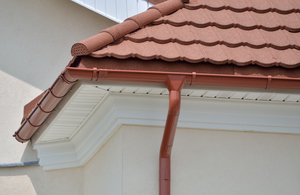 Stages of installation of the storm sewage system are similar to the principle of laying the usual external sewerage. But if in a private house there is no roofing drainage system, then start all the activities you need from its construction. Installation of the roof gutter provides for certain stages.
Stages of installation of the storm sewage system are similar to the principle of laying the usual external sewerage. But if in a private house there is no roofing drainage system, then start all the activities you need from its construction. Installation of the roof gutter provides for certain stages.
- In the ceiling of the house construction holes are made for the rainwater receivers. After the installation and reliable fixation of the elements of the water intake, they are sealed in places of abutment.
- The sewage pipeline and risers are being installed.
- All individual elements are joined and fixed to the construction of a private house by means of special clamps.
Constructive features of the underground part
 In accordance with the developed and approved work plan, which takes into account all the deviations and depth of the system, a trench breaks out. If work is planned on the insulation of pipes using geotextile and gravel, or by arranging a sand cushion, it is important to consider their capacity. All other events are held in accordance with a certain sequence.
In accordance with the developed and approved work plan, which takes into account all the deviations and depth of the system, a trench breaks out. If work is planned on the insulation of pipes using geotextile and gravel, or by arranging a sand cushion, it is important to consider their capacity. All other events are held in accordance with a certain sequence.
After digging the trench, the bottom is tampered. Stones, tree roots and other large debris are necessarily removed, and the remaining voids are filled up. At the bottom is a pillow made of sand standard thickness 20 cm.
The excavation under the collector tank breaks out. As a collector device, it is advisable to use a purchased plastic reservoir. Naturally, with a great desire, you can make a collector with your own hands of concrete, which is poured into the previously constructed formwork.
In the prepared trenches with sand cushions on the bottom are stacked pipes, which are combined into a common system with the help of fittings.
If the length of storm sewage exceeds 10 meters, it is important to additionally install inspection wells.
In the places of connection of receivers of atmospheric precipitation and pipeline pipes sand catchers are necessarily mounted.
All the separate elements and structures are connected in a single circuit, and the joints are sealed qualitatively.
Before pouring a ditch test is carried out by pouring water into the water intake. If there were no weaknesses in the system, then they switch to filling the trench with soil. At the same time, all elements, starting with gutters, trays and ending with pallets, are equipped with gratings. The landlord can connect the rainwater drainage system to the sewerage of the private house.
Man, having equipped himself a livinovku around the house, can significantly prolong the service life of house building, save its residents from puddles and mud, prevent flooding of basement and basement premises, and protect the root system of plants from rot. Of course, it is not necessary to deal with the arrangement of the rainwater diversion system, or the personal business of every landlord, however, the advantage of such a system can not be underestimated.
Any individual building is exposed to atmospheric precipitation.
In addition, if your soil is dominated by soils with an admixture of clay, then after every rain the soil becomes dehydrated, and dirt spreads throughout the area.
And not puddles drying out for a long time, will not add to your land allure.
How to overcome the problem associated with the removal of rainwater?
Make your own hands
 The issue can be solved quickly and efficiently with the help of storm drainage in a country mansion.
The issue can be solved quickly and efficiently with the help of storm drainage in a country mansion.
The sewage system in a private house (about a septic tank - it is written) can be built by a home master with his own hands.
This work is not very difficult.
The only condition - it must be treated with knowledge of the matter.
Before starting to implement the plan, study the Internet or books on this subject.
And in order to ensure that you do not search for information for a long time in the vastness of the world network, this article will, as much as possible, deploy all the necessary information on the topic:
- "How to make livnevku in a private house".
For what purposes is it needed?
Under the influence of atmospheric precipitation, the foundation of the house, slowly but surely, with time, collapses.
In the basement of the house will accumulate water.
In addition, the root system of plants planted on the site will soon undergo a decay process - this will happen if the storm drain is not organized on time (how to make the best septic tank for a dacha read in the article).
A complex of special devices and channels, whose task is to collect, filter and remove atmospheric precipitation in:
- special water reservoirs,
- capacity,
- septic tanks (),
- filtration fields,
- all this is created in order to eliminate excess moisture.
Scheme - what it consists of
The components of the system are as follows.
Arrangement of roof gullies - this is fixed, along with the bevels, gutters.
They collect sediments from the roof surface. They flow down through cone funnels and downspouts.
A certain number of receivers atmospheric precipitation on the earth's surface:
- prefabricated funnels,
- linear drainage,
- sand catchers, etc.
Arrange the devices so that they can take as much moisture as possible.
 As a rule, point receivers are installed directly under the drainpipes, and for some, they find a place on asphalt tracks or in places where paving slabs are laid.
As a rule, point receivers are installed directly under the drainpipes, and for some, they find a place on asphalt tracks or in places where paving slabs are laid.
Intake of linear type mount along the tracks. And for the water to flow well, the coating must be laid under the slope.
Receivers of rainwater are made of polymer concrete or plastic, a special composition.
Manifold well
This device is necessary for the collection and further filtration of liquid into the ground. The reservoir should be as large as possible.
Inspection hatches
Without them, it is impossible to carry out preventive inspection and clean the channels if they are contaminated.
Basically, they are equipped in the places of joints of channels and at the points of their intersection. It is in these fragments that the possibility of clogging channels is maximal.
Variants of storm sewage
Underground
This is when all components of the device are located below ground level.
If this issue is considered from an aesthetic point of view, then there are many positive points.
But, on the other hand, in order to perform an underground stormwater, it is necessary to do a large amount of land work and to lay out a considerable amount of money.
This prescription is compulsory.
If desired, you can build a storm sewage system for the needs of a private home of any configuration and complexity.
How to calculate the depth of the channel laying
If the underground pipeline has a cross section of no more than 0.5 m, then it must be buried in the ground at a level of 30-35 cm.
If the diameters of the channels exceed this figure, then storm sewage should be laid at a depth of at least 70 cm.
If your land already has drainage system, then the downpour should be placed above it.
To ensure that the water can move freely through the pipeline, you need to choose the right bias.
Step-by-step instruction
Before embarking on the implementation of their plans for equipping the storm shower, make sure that your mansion is equipped with water collection and disposal facilities.
Digging out the moat, the depth and width of it should be given the inclination.
If you consider it necessary to insulate the structure, then the dimensions of the excavation must meet these additional requirements.
Carefully compact bottom of the trench. After that, we fill up with a layer of sand, at least 20 cm thick.
In a specially designated place we dig a pit, in it we will place a reservoir for collection of sewage.
Most likely, it will be a ready-made plastic container (septic tank).
As an alternative method, you can make a tank of concrete.
On the sand preparation we lay the gutters or pipes.
It depends on what type of storm sewer you will mount.
Next step - connect all the individual components to one device.
Pipes are connected by means of fittings.
All joints, without fail, are sealed.
Where the trays connect to the collector, we install sand catchers.
On sites that are long (more than 9 - 10 meters), and in places of broken pipes, you can not do without installing inspection wells.
We check the structural capacity For leaks, pouring liquid into the water intake. If problems are found, they need to be fixed.
The final stage. Pipes that are underground are covered with soil, and channels located above the ground level are covered with decorative protective grilles.
In any private structure installation work for the arrangement of storm sewage should be carried out in the sequence described above.
Do not forget to make a drainage from all the roof slopes. Only in this way you will be able to protect your land allotment and local area from the influence of excessive moisture.
Remember! Livnevku and drainage is never integrated into one system. These schemes should complement each other, and not mutually exclusive.
Because during heavy rains, a joint device can not withstand the onslaught of the water element.
Owners of country mansions can safely connect the livnevku to its own sewage system. Because there are no harmful ingredients in the rainwater, and it does not require cleaning measures.
If you improve your house and the surrounding area with a surface drainage device, this will significantly prolong the life of the structures.
Thus, you will save yourself and your household from not drying puddles.
An uncomplicated device can be made by hand. Nothing complicated in this.
The work of the master is afraid. It is only necessary to begin. And if there are any difficulties, all the answers to the questions can be found in this article.
What pipes to use and how deeply from digging into the ground, look in the video.
Rains and thawed spring waters spoil the mood of the owner of a private house, not only in connection with dull weather. Atmospheric water adversely affects the condition of the site, vegetation, buildings of the country estate. To avoid watering the territory and destroying the foundation, it is possible and necessary to equip the storm sewers.
What is storm sewage and its benefits?
Livnevka - a system of waterways, water receivers and other devices that provide collection and removal from the roof of the house, as well as from a stretch of rain and meltwater.
Thus, the main function of the storm sewage system is to divert excess atmospheric moisture. Proceeding from this, it is possible to single out the following advantages of arranging stormwater on the territory of a country house and not only:
- the storm sewage system helps to keep the foundation and basements from the effects of moisture;
- saves from unnecessary watering of the site, which can lead to the death of plants;
- helps to avoid the formation of puddles on the site;
- prolongs the service life of sidewalks and paths, saving from the erosion of the water road cushion.
Types of storm sewers
Depending on how the collection and diversion of water, storm catchers are divided into 2 categories.
- Point systems. Water enters the rainwater intake, which can be several on site. They are connected by pipes into a single network. Sprinklers are installed under the drain pipes, transporting water from the roofs, as well as in the lowlands of the site.
- Linear systems. Water is collected from more extensive areas, such as roads and sidewalks.
Storm sewers by the method of the device are divided into 3 types.
- The most simple version storm sewage are systems of open type. They include open gutters and channels for collecting and discharging atmospheric water from the site. Open water showers are the cheapest and suitable for small areas.
- The most complex in the device - closed stormwater. In such systems, water first goes to special collections, which include rainwater trays and trays, and from them - through pipes to sewers, central sewer networks, septic tanks, etc.
- Mixed rainwater systems include elements of closed and open types.
To date, when installing a storm sewage system, several types are used at once.
The device of storm sewage and the principle of its operation
The composition of the storm catcher may include the following elements:
- gutters, drainpipes, funnels and drainpipes;
- rainwater receivers and door pallets;
- ground trays and gutters;
- underground pipes;
- sand trap;
- manholes;
- collector.
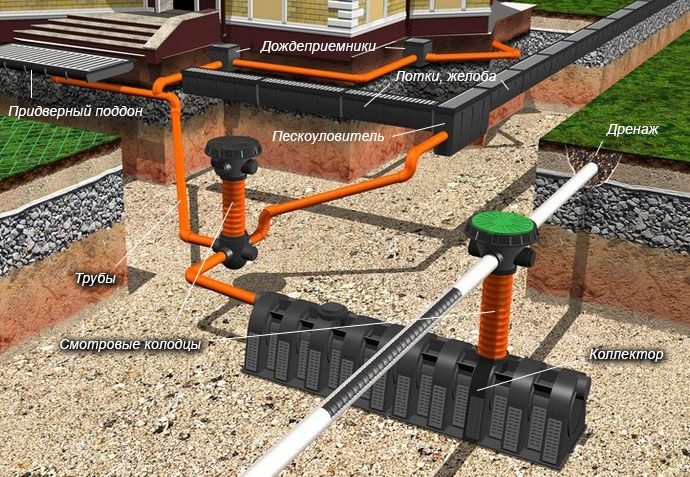
Consider the principle of the most effective storm sewage, which includes elements of all types of storm showers. Let's start with the description collecting water from roofs.
- If the roof is flat, then it is equipped with an internal livnevke, the main catchment element of which is a funnel installed at the lowest point of the roof and hermetically connected to a spillway or riser. This pipe is inside the building. Passing along the riser, the water is removed from the house through the rainwater intake.
- Rain or meltwater from pitched roofs is collected in gutters passing along the perimeter of the roof. Further it enters the outlet funnels connected to the drainpipe, which discharges the drains to the rainwater intake.
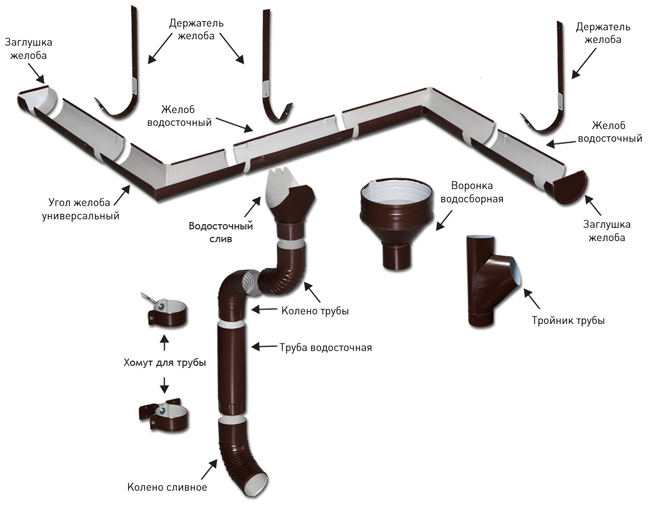
In the ground storm sewage, water is collected in special pallets located near the entrance to the house and other buildings, as well as in trays and gutters with bars running along the tracks and areas.

Pipes, which are an underground element of storm sewage, are connected to the rainwater trays, pallets, trays. Before these pipes are installed sand catchers, which are special boxes, in which leaves and other large debris are retained. This protects the entire internal system from clogging. Under the underground pipes, water enters the collector, and from it - either into the central sewage system, or into a ravine, stream, pond.
Atmospheric water collected by storm sewage can also be used for irrigation and other technical needs. To do this, it is first cleaned in a special filter.
Purification of storm water
In some cases, before discharge of runoff drains into the terrain, into a reservoir or using water for irrigation, storm water should be cleaned. For a private house, in this case, sorption filters are used, in which coal, which absorbs oil products and suspended particles, serves as loading. This is especially important when discharging fishery use into reservoirs, for which MPC norms for many pollutants are much stricter than for rivers, lakes and ponds for drinking use.
Such filters are very convenient in operation, since they have small dimensions and a sufficiently long service life of about 7 years.

Note! It is not recommended to discharge storm water into the public sewage system to an autonomous treatment plant, as this can lead to its breakdown.
Arrangement of storm water drain by own hands
Mount the storm sewer on the site of your own country house can be an independent effort. To do this, you must first make calculations and make a plan, select materials and then go directly to the installation.
Features of the storm sewage system
- To reduce the labor and financial costs of preparing trenches for storm sewer pipes, you can combine them with drains in a single trench. In this case, the drainage pipes are laid below the storm water.
- Stacking inner tubes should be made at least 30 cm below the freezing point of the soil in winter.
- The bottom of the trench must be prepared for packing, rammed and covered with a sand pillow 10-15 cm thick.
- If the pipeline stretches for a distance exceeding 10 meters, then every 5-6 meters, as well as in the places of turns and connections with other pipelines, forks, it is necessary to provide for the installation of inspection wells.
- Laying pipes is necessary under the slope, as the water in them moves by gravity. The pipeline should approach the collector at an angle of 2 degrees.
Necessary calculations and choice of materials
Before proceeding to the project, and even more so to installing the storm sewer system, it is necessary to make calculations.
The calculation of the productivity of the storm catcher, which is necessary for determining the diameter of the pipes, is described in detail in SNiP 2.04.03-85 "Sewerage. External networks and facilities ". It presents the formula, allowing to calculate the volume of water taken and discharged:
Q =q20xFxΨ , where
- Q - the volume of water taken and diverted by the Livny water;
- q20 - precipitation intensity typical for this area, n * ha / s;
- F is the area of the catchment area, in hectares;
- Ψ is a coefficient that depends on the material that covers the catchment area, it is also called the moisture absorption coefficient.
The intensity of precipitation can be found in the meteorological service. In addition, this indicator, as well as the coefficient, can be found in the SNiPe.
Correction factor, indicators:
- 0,35 for lawns, turf or open ground;
- 0,4 for crushed stone;
- 0, 6 for crushed stone with bitumen;
- 0,85 for concrete;
- 0.95 for asphalt;
- 1.0 for the roof.
Calculating the volume of waste, you can determine the cross-section of pipes and their slope according to the table.

Table - Cross-section of pipes and their slope
However, the presence of sand catchers in front of the entrance should imply a reduction in the slope of the pipes for better settling of slurries. Typically, for storm sewage, arranged in private areas that are located in the middle band, pipes with a section of 110-150 mm are used, the diameter of the collector may be 200 mm. The average slope for each running meter of pipes in 110 mm is 2 cm, 150 - 0.8-1 cm, 200 - 0.7 cm.
The dimensions of the manholes depend on the cross-section of the pipes entering it. When sewerage is installed in a section for pipes up to 150 mm, the diameter of the well is allowed to be 70 cm, provided that its depth does not exceed 1.2 m. On average, the cross section of the wells should be 1 m.
For the arrangement of storm sewage in-house, it is most convenient to use all the plastic elements, since they are sufficiently durable and easy to install.
What is the plan
The storm drainage plan should be a scheme in which the location and dimensions of all the elements of the storm shower are indicated, including connectors and rotations of pipes, inspection wells. To draw up a plan for a storm drain, it is necessary to determine the lengths of pipes, trays and gutters, depending on the location of these elements. When designing the roofing part of the storm sewer, you need to know the perimeter of the roof, which determines the length of the gutters.
In addition, in the project it is necessary to note sanitary zones for storm pipes, making 5 meters. In this range, you can not conduct any construction, organize compost pits, heaps of garbage. It is also forbidden to plant large trees and shrubs, closer than 3 meters, and clutter up access to manholes.
Installation of storm water sewerage step by step
After the drawing is done, the materials are selected and purchased, you can start installing the storm sewer system.
Installation of the roofing part of the rain shower

Installation of surface and underground storm water drainage systems
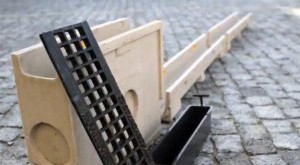
Thus, the installation of a storm system by one's own hands is not a complex exercise, but requires a responsible approach. After a livnevka will allow longer to stand structures, save roads, as well as plants and soil fertility.
Installing the chute holder
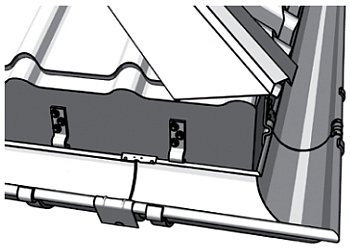


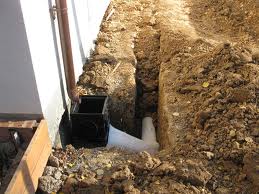
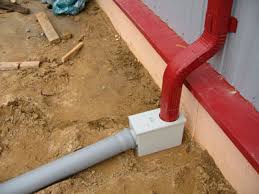



Any a private house It is constantly exposed to atmospheric precipitation. If, in addition, the soil on the site has admixtures of clay, then constantly dehydrated soil and puddles standing in the courtyard do not give your house aesthetics. Cope with the problem of rainwater removal is capable of storm sewerage in a private house. It is quite possible to build it yourself, at the beginning of the construction of the house. Alternatively, it can be laid intentionally, near a house already built, if such work was not carried out in due time.
The main purpose of a storm shower in a private house is to collect and then divert melted and rainwater from the house and from the site to special catchment facilities, into water basins, into a deep drainage system, off site or into a common sewage system. In addition to the collection, a properly installed livnevka in a private house with its own hands is able to clean the water that has come into it from impurities and sand. The water leaving the system is clean enough and does not pollute the surrounding areas.
As a device for surface drainage, livnevka protects the buildings standing on the site from movement and destruction. If the soil on the site is constantly wet, then the impact on the foundation of differently directed warp vectors will affect its strength. As a result, subsidence, the slope of the house, the appearance of cracks on its walls are possible.
The main components of the system
The device of storm sewage in a private house assumes the presence in its composition of the following elements:
- , located on the surface or closed channels, located under the ground. Are installed taking into account the slope towards the water catchment. On them, water enters the reservoirs or is taken directly outside the site.
- water inlets. They are designed to collect water draining from the roofs of buildings. The most suitable places for their installation are under the drain pipes. Sprinklers are made of plastic or polymer concrete in the form of rectangular tanks of various volumes and equipped with a basket for collecting various garbage with the water. From them, water flows through the canal system into water reservoirs;
- pallets;
- manholes. They are designed for preventive inspections and cleaning of channels and pipelines in case of their clogging. As a rule, they are equiped at the junctions of the canals and in the places where they intersect, as it is in these places that the risk of clogging up the channels is most likely;
- sand catchers They serve for the collection of solid particles in the water entering the canals. They are installed on surface drifts;
- collector well is designed for collection and subsequent filtration of water into the soil.
Types of storm sewage
Livnevka in a private house can be linear, dotted, and also mixed. Each of these types is different for its device and purpose.
Linear (open type) drainage system
This system is easy to manufacture and quite effective. It is a network of surface metallic, concrete or. In these channels, water enters the drainpipes, going to the general drain or special reservoirs. Above the trough are covered with grilles protecting them from debris, as well as performing decorative functions. Separate troughs are joined together with a sealant to prevent water from penetrating between joints.
Such storm sewerage in the country or in a country house has a greater coverage, water is collected from tracks, sidewalks, various sites, and not just from roofs.
 In the photo, an example of an open drainage sewer of an open type from drainage trays with bars
In the photo, an example of an open drainage sewer of an open type from drainage trays with bars Advice: When an open water drainage system of an open type is laid by one's own hands, the inclination of all gutters must be taken into account. Otherwise, despite the presence of surface channels, the water will not drain over them, but will cover the entire site, not having time to go into the catchment.
Spot (closed type) sewerage
If the choice fell on the scheme of storm sewerage in a private house of point type, then all water intake pipelines should be located underground. Water, flowing down the pipes from the roofs, gets into the grids covered by the grids, and from them into the underground channels. Water is diverted to them in the places designated for it or simply merges outside the boundaries of the site.
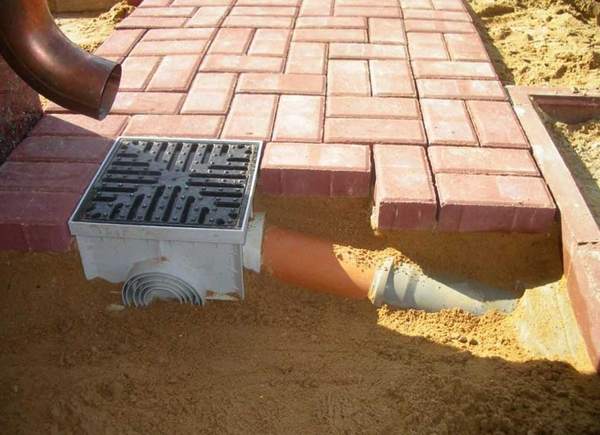
Tip: Since the laying of underground utilities represents the complexity of design and construction, its construction should be carried out only at the design stages of the house itself. Later, it will be almost impossible to perform such work.
Mixed sewerage
To this type of sewage resorted in cases where it is necessary to save on labor or financial costs. This system can include both open-type elements and components of a point-to-point sewage system.
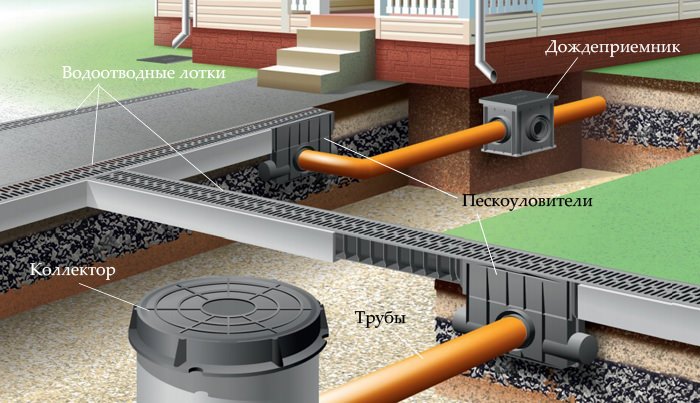
Calculation of volume, depth and slope
If you want your house and plot to be reliably protected from flooding, siltation and dirty rainwater flows, you need to correctly calculate and lay the storm sewer in the project. The main calculation of storm sewage is to ensure that all water entering the territory equipped with livevkami goes to the places allocated to it without rest and is regulated by SNIP 2.04.03-85.
Calculation of channel depth
If the section of underground pipelines does not exceed 0.5 m, then they are buried to a level of 30 cm. With large channel diameters, the depth of storm sewage in a private house increases up to 70 cm.
If the site is already laid, the storm sewage system in a private house is located above this system.
Advice: All elements are recommended to be buried to the freezing level of the soil, but in practice it is possible to arrange them and closer to the surface, providing them with insulation by backfilling a layer of gravel and geotextile laying. Thus, the expenditure and laboriousness of excavation work will be reduced.
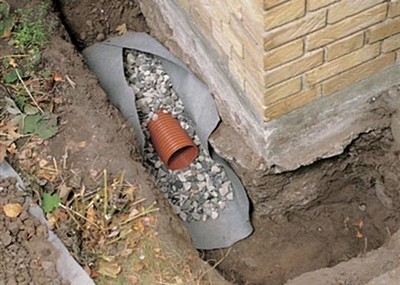
Calculation of the volume of waste discharged from the site
To calculate the volume of waste, it is necessary to be guided by the following formula: Q = q20 x F x ¥, where:
- Q - the volume that must be taken away from the site;
- q20 - the amount of precipitation. These data can be obtained from the meteorological service or taken in the same SNiPe 2.04.03-85;
- F is the area from which water will be discharged. For a point system, the projection of the roof area onto the horizontal plane is taken. In the case of equipment of the linear system, all areas taking part in the water disposal are taken into account;
- ¥ - coefficient that takes into account the coating material, which is equipped with a site or covered with a house:
- 0,4 - crushed stone or gravel;
- 0,85 - concrete;
- 0,95 - asphalt;
- 1 - the roof.
Calculation of the required channel bias
Correctly selected slope guarantees free flow of water through pipelines under the influence of physical laws. The required slope of storm sewage is determined depending on the diameter of the pipes used. If the pipes have a diameter of 20 cm, then the coefficient 0.007 is taken into account. That is, 7 mm per running meter of the pipe. With a diameter of 15 cm, the coefficient is 0.008.
The slope of the channels in the open system varies between 0.003-0.005 (this is 3-5 mm). But the pipes connected to the rainwater collectors and storm wells should have 2 cm of slope for each running meter.
Mounting of stormwater
Before you start, you need to make sure that the house is equipped with water collection and drainage systems (drainpipes, risers and gutters). Further, depending on the type of the selected system, storm sewerage is installed by hand:
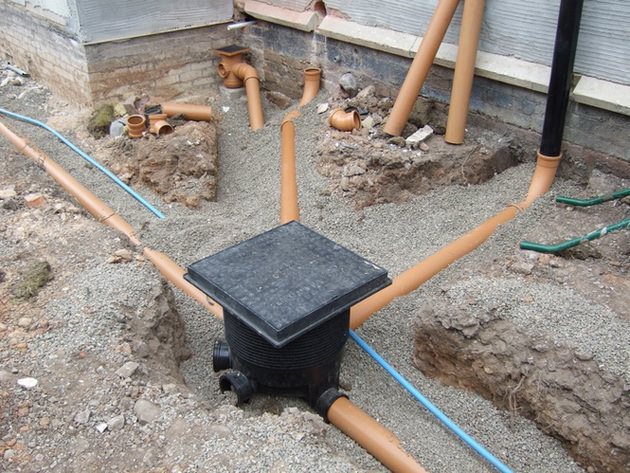
- A trench is being dug out of the necessary depth and width, taking into account the slope. If the decision is made to insulate the pipe with gravel and geotextile, the dimensions of the trench should be increased.
- The bottom of the trench must be carefully tampered, after which the sand cushion should be covered with a layer of 20 cm.
- In the allotted for this place, a pit is excavated to install a reservoir-reservoir in it. In this pit is inserted a ready-made container of plastic. Alternatively, a concrete tank can be made.
- The sand cushion is laid pipes or trays, depending on whether the storm sewer external or spot will be mounted. The connection of individual elements into a single system is made. Pipes are connected together by means of fittings. The channel joints are sealed.
- In the junction between the trays and the collector, sand catchers are installed.
- In the places of pipe bends, as well as on long sections (more than 10 m) it is recommended to equip manholes.
- The system is operable to check for possible leaks. When they are detected, elimination of shortcomings is performed.
- Underground pipes are filled with soil, and the above-ground channels are closed by gratings.
In this sequence, storm sewage is installed in any private house. Remember that water should be diverted from all the slopes of the roof. Only in this case, the adjacent territory and site will be protected from the effects of excess moisture.
Mounted by all the rules of the storm drainage in a private house with their own hands will save the owners from flooding the site, slush, numerous puddles in front of the house, and also protect the foundation of the building from gradual destruction.
The process of installing a storm sewer can be viewed on video.
